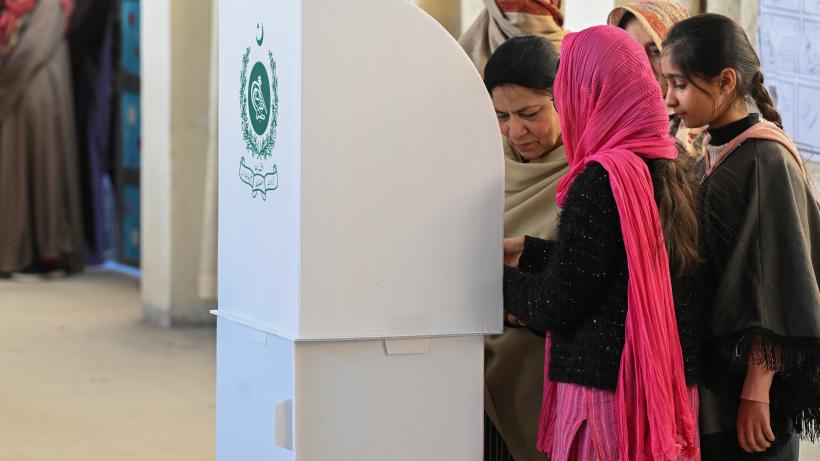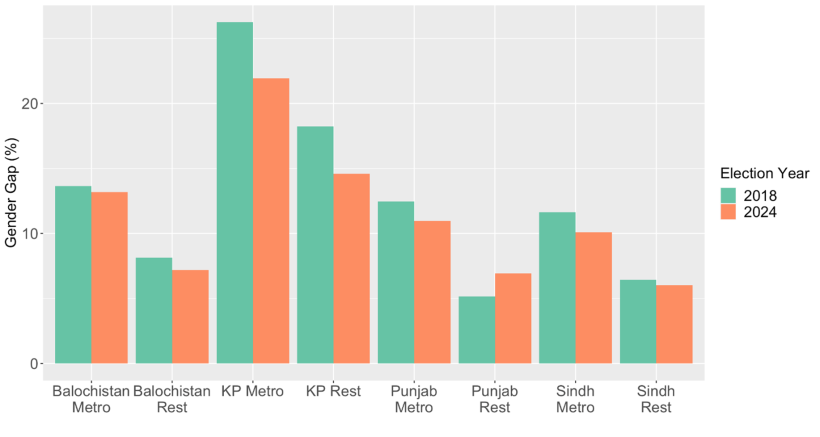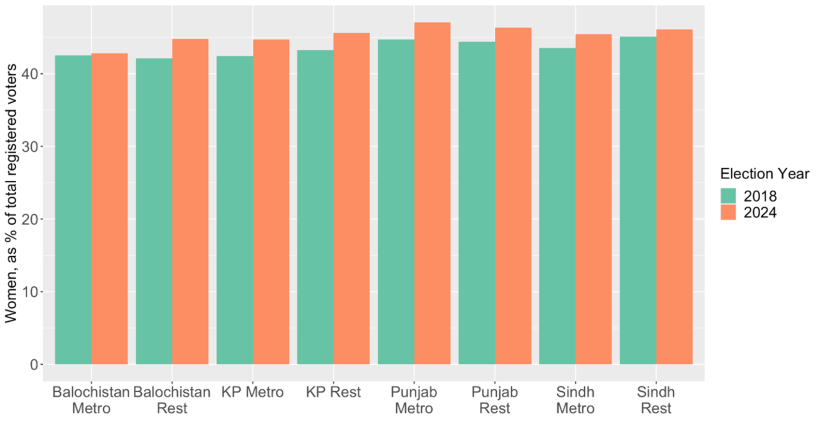
Understanding the gender gap among Pakistan’s voters
Despite an increase in women registered to vote, Pakistan sees a 9-10% gender gap in voter turnout; unexpectedly, this gap is much higher in urban areas than in rural ones.
Pakistan has one of the largest gender gaps in voter turnout among electoral democracies around the world. In 2018, this gap was 9%: turnout among male voters was 55.7%, compared to 46.7% among female voters. In the most recent elections, held on 8 February 2024, turnout for both groups slightly declined – to 51.7% for male voters and 41.7% for female voters – but the gap remained unchanged. While efforts by the Election Commission of Pakistan (ECP) over the last decade have led to a steady increase in the number of registered women voters, mobilising their turnout remains a challenge.
To design effective policy measures and to target these efforts appropriately, it is important to know where the gaps are most severe, and what factors constrain women’s turnout. The 2017 Elections Act mandated the ECP to make gender-disaggregated electoral data at the level of the polling station publicly available for the first time. This requirement, a long-standing demand of civil society and women’s rights organisations, makes it possible to understand patterns of electoral participation.
Variation in women voters’ turnout
The national level estimate of the gender gap in voter turnout masks important variations. The gap varies considerably across Pakistan’s geography. In 2024, the Khyber Pakhtunkhwa (KP) province registered the highest gender gap in turnout at 15.7%, while the gap in Sindh province was nearly half the magnitude at 7.4%.
This gap also varies across the rural-urban divide, with large cities in each province registering a greater difference in women and men’s turnout than the rest of the province(s). This phenomenon was first identified in the 2018 election by Cheema et al (2021), and a preliminary analysis of 2024 turnout statistics shows that this was no anomaly. The pattern of low female voter turnout in urban metropolitan areas has persisted for five years on.
Figure 1 shows the gender gap in turnout for each province, in its metro areas (defined as urban localities with a population of 500,000 or more, as per the 2017 census) versus the rest of the province, in 2018 and 2024.
Figure 1: Gender gap in voter turnout by province and metro area (2018 and 2024)

What is it about cities that constrains women voters’ turnout?
This pattern is concerning given Pakistan’s high rate of urbanisation. While policymakers are rightly concerned about the implications of this trend for service delivery, housing, employment, and environmental degradation, its consequences for gender equality, particularly with regard to political participation, have so far received less attention. It also defies conventional wisdom about the drivers of political participation. Women in urban Pakistan are more highly educated, marry at later ages, and have greater say in household decision-making than their rural counterparts. These are all individual level factors generally associated with higher, not lower, political participation.
Urban turnout, interestingly, is lower than rural turnout in Pakistan, even among men. This tracks with similar patterns in neighbouring India, where turnout is lowest in its largest cities. There is little consensus on the reasons for this, though scholars have pointed to factors like apathy among middle-class voters and the challenges for internal migrants.
Yet, the higher gender gap in cities (illustrated in Figure 1), suggests that the metropolitan context is especially constraining for women’s political participation in Pakistan. A possible explanation is the barriers to women’s mobility, which may paradoxically be higher in cities, due to social norms and heightened concerns about women’s safety in dense and diverse urban settings. Further research to understand what is driving these patterns is key to designing the right policy levers to address the gap.
Implications for policy
The ECP’s efforts at increasing women’s electoral participation have largely focused on closing the gap in voter registration, rather than turnout. These efforts have also been successful, with the registration gap reducing for the first time in the leadup to the 2024 elections. The ECP has been able to achieve this through careful targeting of registration drives to areas with the highest registration gaps. However, the rural-urban pattern in women’s turnout does not extend to women’s registration (see Figure 2).
Figure 2: Women’s share among registered voters by province and metro area (2018 and 2024)

Geographically targeted efforts to increase women’s turnout need to involve a strategy that accurately reflects the spatial variation in turnout. Bundling efforts to increase both registration and turnout in the same drives is unlikely to be effective.
To design effective and context-appropriate policy measures, we need to understand whether and how the constraints faced by women in cities are different. A comparison of field experiments conducted by Gine and Mansuri (2018) and by Cheema et al (2023) shows that while individual awareness campaigns targeted to women in rural Sindh improved their turnout, a similar intervention in urban Lahore was ineffective, unless it also targeted men in households. A one-size-fits-all approach is unlikely to be effective.
To better understand the constraints to urban women’s political participation, in ongoing work supported by the IGC, we will conduct surveys with women in matched rural and urban polling areas to understand their participation decisions, and constraints faced in the most recent 2024 elections. This is with a view to generate evidence that could inform context-specific policy measures to improve women’s turnout in future local and national level elections.

